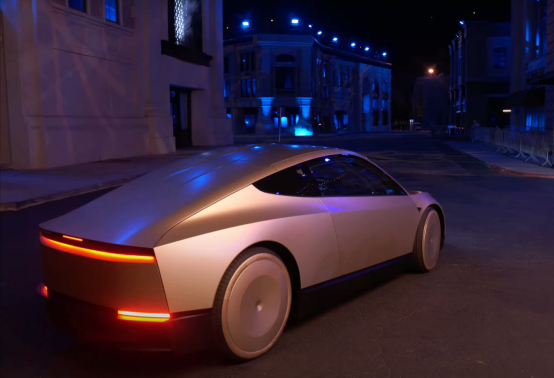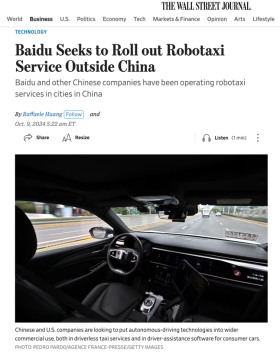On October 11 at 11 AM Beijing time, Tesla unveiled its long-delayed Robotaxi. The Robotaxi is a concept car. It lacks a steering wheel and pedals. Tesla named it Cybercab. The expected cost is under $30,000. It aims for a launch in 2026. Tesla CEO Elon Musk stated, “The cost of autonomous ride-hailing is very low. Including taxes and fees, the price may reach $0.30 to $0.40 per mile.” Musk claimed that each ride-hailing driver could manage a fleet of 10 to 20 Cybercabs. After obtaining regulatory approval, all Tesla models will feature FSD, transforming them into self-driving cars. With the arrival of Tesla’s Cybercab, Chinese autonomous driving companies will face a strong competitor.
Tesla’s Cybercab enters the market. The race for autonomous driving begins. Deep learning and computer vision technologies rise. They offer new solutions for traffic safety and efficiency. Autonomous driving combines artificial intelligence, communication, semiconductors, and automotive technologies. It involves a long industrial chain and vast value creation potential. Countries compete fiercely in this space. China and the U.S. lead in the number of autonomous driving companies. Their technological competition intensifies. Before Tesla launched its Cybercab, China’s Lobo and Waymo, a Google subsidiary, were already in the race. On October 9, Lobo announced plans to enter overseas markets, drawing global attention. Reports say Lobo seeks to launch its autonomous taxi service abroad to extend its competitive edge beyond mainland China.
According to insiders, RoboTaxi aims to test and deploy its autonomous taxis in Singapore and the Middle East. The company has discussed plans with local businesses and regulators. In response, Hong Kong’s Transport and Logistics Bureau stated that a new regulatory framework for autonomous vehicles will take effect in March 2024. The Transport Department expects to announce successful autonomous vehicle projects by the end of 2024. RoboTaxi insiders revealed plans to launch the Apollo autonomous driving open platform version 10.0, designed for global users. This version will feature Baidu’s latest autonomous driving model, ADFM. This upgrade will significantly enhance the platform’s safety, intelligence, and usability. It will be the world’s first autonomous driving open platform equipped with a large model. Earlier this year, Baidu introduced the Apollo ADFM, the first large model supporting L4-level autonomous driving applications. It ensures safety surpassing human drivers by more than ten times and covers complex urban scenarios. RoboTaxi’s sixth-generation vehicle fully integrates the “ADFM large model + hardware products + safety architecture.” It guarantees stability and reliability with ten layers of safety redundancy and six MRC safety strategies. The production cost remains below $30,000, making it highly competitive. Beyond Tesla, another autonomous driving giant in the U.S., Google, has been very active. Waymo expands its operational areas in San Francisco and Los Angeles. It has partnered with Uber to launch hundreds of autonomous taxi services and plans to collaborate with General Motors and Hyundai to accelerate its presence in the autonomous driving sector. “Foreign competitors” are gaining momentum. Chinese companies need to seize this opportunity. Although Tesla’s Cybercab may not launch until 2026, its L4-level autonomy will initially restrict operations to specific areas, similar to Waymo’s approach. Insiders believe Tesla will arrive late in the Chinese market but will not miss the opportunity. Musk stated that outside North America, the deployment of autonomous driving capabilities lags far behind Tesla. Tesla seeks approval from regulators in Europe, China, and other countries for version V12.5 or V12.6 of FSD. This version may receive approval by the end of this year and plans to enter China in the first quarter of next year. This situation raises industry concerns about the global autonomous driving competition. This year, Waymo quickly expanded in the autonomous driving field. By June, Waymo’s self-driving cars had traveled over 22 million miles. In August, Waymo surpassed 100,000 weekly orders in San Francisco, overtaking China’s largest ride-hailing platform, Didi. Many experts suggest seizing the industry’s development window. They advocate supporting national teams like Didi, Pony.ai, and WeRide to promote large-scale autonomous driving in China. “China and the U.S. have been the two most influential forces in global autonomous driving,” said Chen Yanyan, a professor at Beijing University of Technology. “For over a decade, China has worked hard to catch up with the U.S. Technologically, we are now on par. To gain an advantage in future AI competition, especially in autonomous driving, the government and businesses must collaborate.” Chen believes that China needs to make greater strides in autonomous driving legislation. The government should create a positive and open policy environment for the industry, leveraging China’s rich scene advantages to accelerate implementation. Currently, most cities developing autonomous driving operate in limited areas and times. Local legislation must speed up, strongly supporting companies in expanding their operational regions for large-scale deployment. On the other hand, the government should encourage companies to innovate independently. They need to achieve self-control in key autonomous driving technologies quickly, improving technical performance and avoiding bottlenecks. Companies must enhance their research efforts, making breakthroughs in areas like large models and computer vision.

